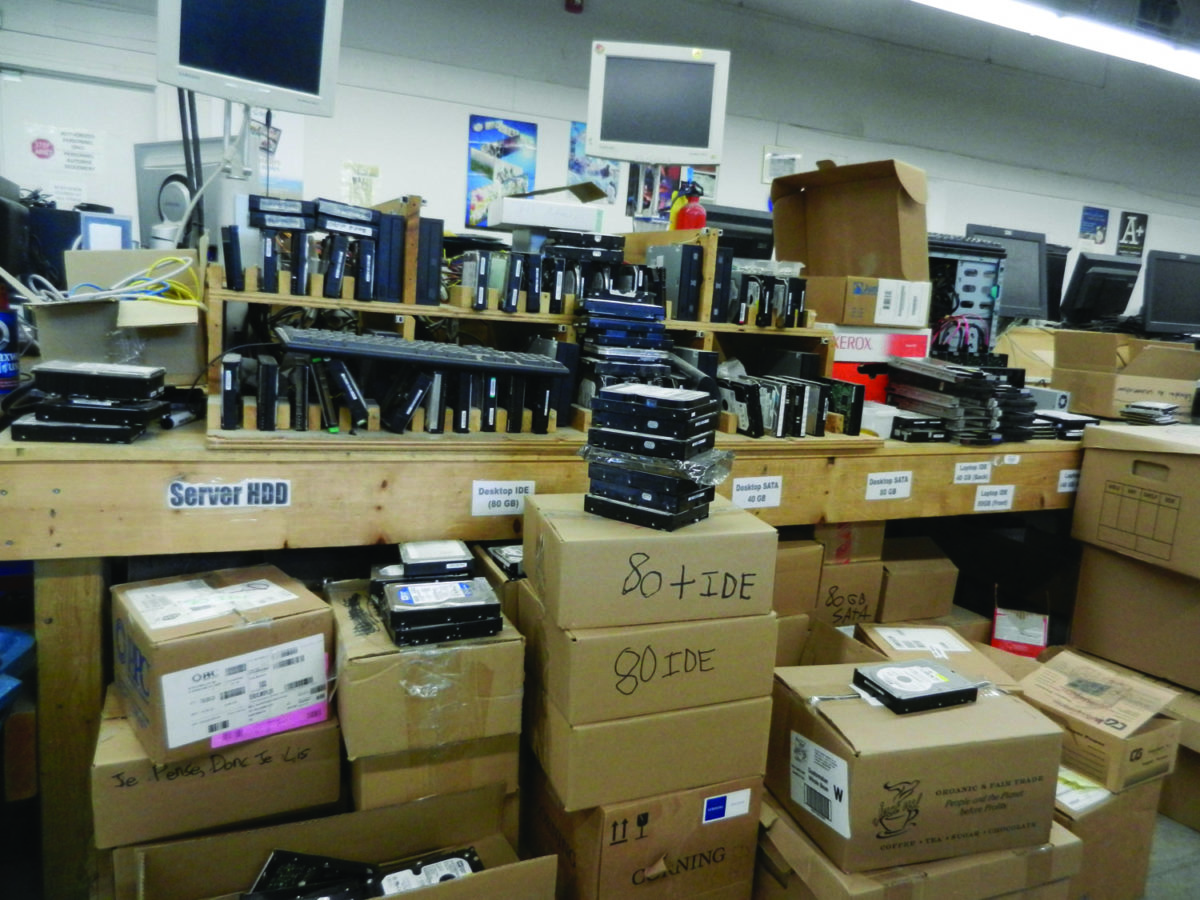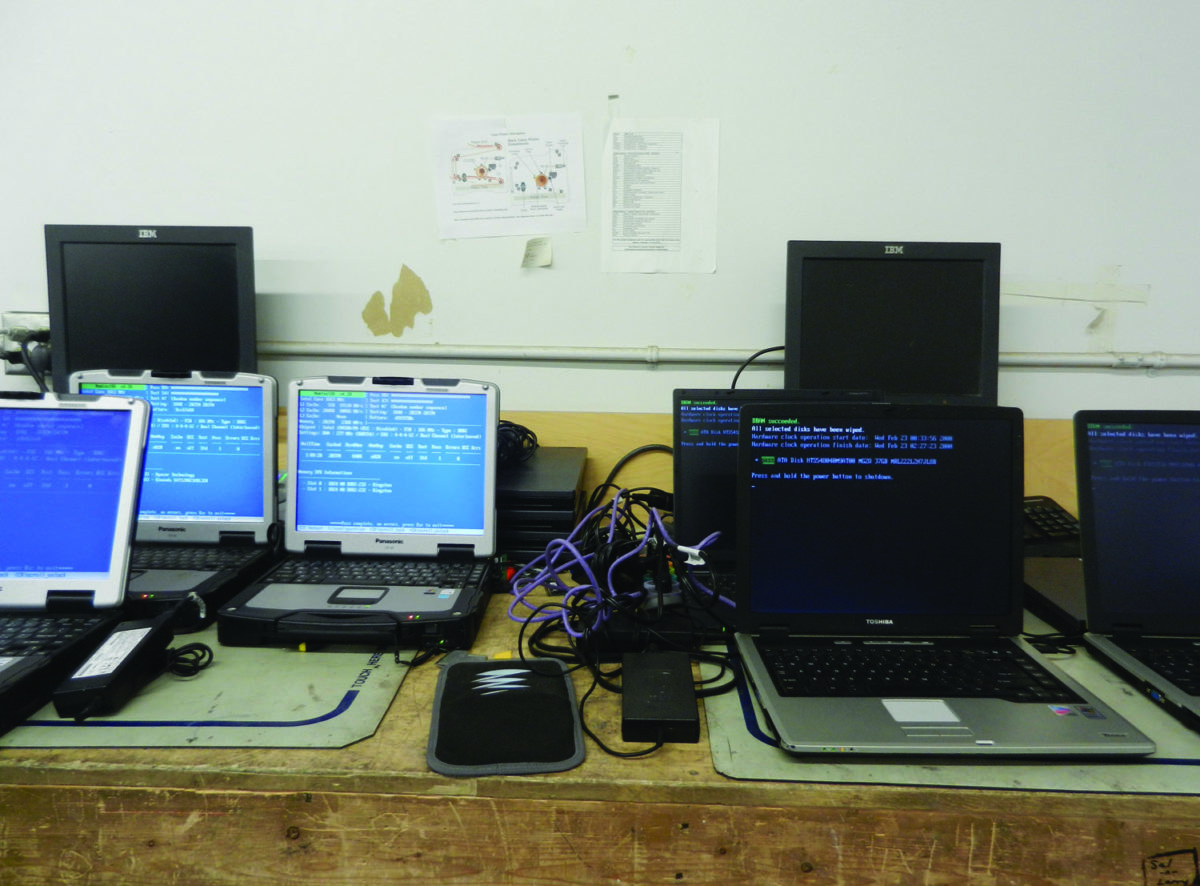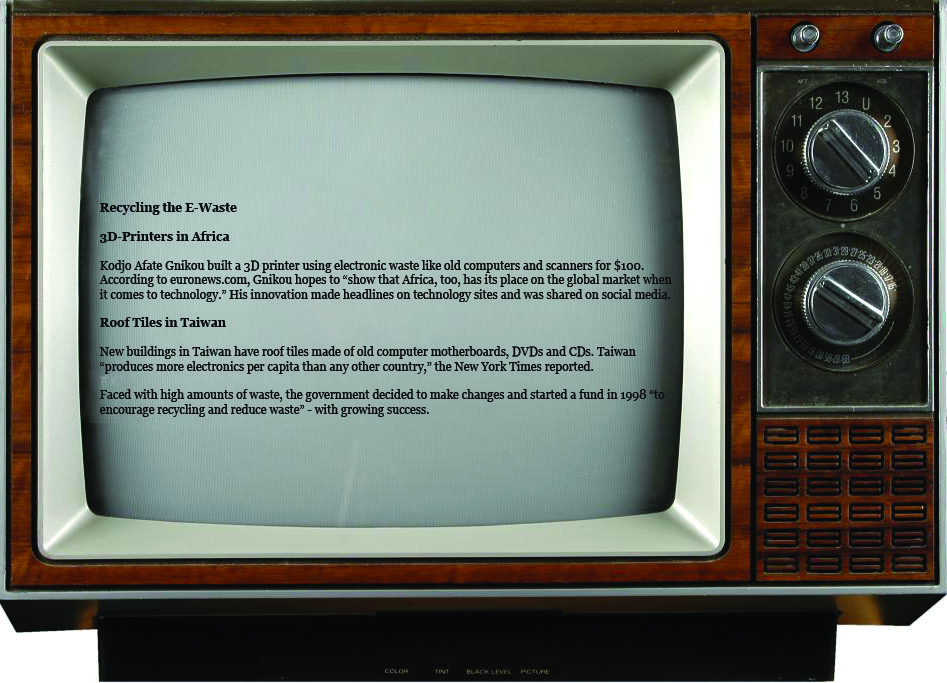
Bundles of old electronic devices wait for recycling in every corner in a storehouse at the Fredericton industrial park. Broken tube TVs and flat computer screens sit in storage racks. Hundreds of computers and laptops are stacked on palettes. Cables, old printers and laptop bags fill waist-high card boxes.
Millions of dollars once spent for top-notch electronics are now nothing more than electronic waste.
Electronic waste, or e-waste, is defined by the Canadian government as electronic devices which are “not suitable for reuse” and “have reached the end of their intended useful life.”
With the lifespan of computers and cell phones shortening, the piles of e-waste grow.
Unlike every other province in Canada, New Brunswick has no electronic recycling program in place, even though the NB Environment Department is working towards one. But St. Thomas students like Amanda Walker have brainstormed ideas for a class project to solve electronic waste issues.
E-Waste? Never heard of it
“A lot of people have no idea about electronic waste. Before this class, I didn’t even really think about electronic waste. So, I think the project is really good to bring awareness to individuals and to St. Thomas as a whole,” Walker said.
In groups, the approximately 40 science and technology students researched the major challenges that come with electronic waste. Walker said she never realized how harmful electronic waste is.
Most electronic devices contain hazardous materials such as lead, mercury and cadmium.
According to the United Nations Environment Programme, cadmium causes kidney and skeleton damages. Lead affects nearly every part of the human body: nerves, the heart, blood vessels, kidneys, the stomach, intestines and reproductive organs.
The programme said major amounts of e-waste are shipped from developed to developing countries. Often, these old electronics are openly burned, leading to health and environment issues.
On the other hand, parts of electronic devices contain gold, silver, aluminum and copper which can be sold after recycling.
Walker blames advertising and marketing for contributing to the electronic waste problem.
“Technology is being developed so quickly that we don’t have the capability to keep up with it.”
STU’s hidden E-waste chamber

Keeping up with technology is part of Dan Hurley’s job. The IT director said the university replaces 100 computers every year. Usually, the new computers arrive during summer, but when electronics break down in the middle of the academic year, Hurley needs a place to store them.
Under STU’s admission office, old laptops, overhead projectors and many DVD players find a home. They are joined by metres of cables, some floppy disks and even an old film projector that Hurley calls “’60s vintage.”
“You spent a lot of money on it, so you don’t just want to throw it in the garbage, that feels wrong. So people tend to want to hold on to it and then after a few years it’s really old and really useless to anyone,” he said.
“People don’t appreciate how rapidly technological equipment depreciates.”
Finding a place to recycle STU’s old electronics, especially the computers, is a challenge.
Fredericton’s landfill accepts electronics for disposal, but doesn’t recycle them because of the glass, plastics and toxins in electronics like CRT monitors.
In northeastern New Brunswick, landfills accept electronics for recycling. Residents in Saint John can bring old computers to an “e-waste disposal room” at UNBSJ. In Woodstock, a school project about electronic waste recycling became a real company, Atlantic E-Waste Solutions. People in Edmunston have access to a program called Resnet Recyclage which offers workshops to learn how to dissemble and build a computer with recycled parts.
But Hurley was looking for a location close to campus and found Computers for Schools in Fredericton’s industrial park.
Finding solutions
Computers for Schools is a nationwide organization led by the federal government. In every province and territory, Computers for Schools accepts and collects old computers from institutions like government offices, companies, law firms and St. Thomas.
Employees, technicians and volunteers sort and refurbish them. Program co-ordinator Roy Crawford said public and First Nation schools are the primary recipients, but libraries and non-profit organizations also receive repaired computers from them.
Crawford said it takes them three hours to repair a computer. Before one is shipped, the team makes sure everything is working.
Sometimes, they receive electronics and electronic equipment they can’t fix. Crawford said before electronics go to the landfill, Computer for Schools ships everything they can’t recycle to FCM Recyclage in Quebec, a recycling company that dismantles devices like CRT monitors or tube TVs.
Although Computers for Schools fix approximately 4,000 computers every year, few Fredericton residents know about the 20-year-old service.
“We’ve partnered with the Chamber of Commerce in the city in September. We did a collection day that helped to get the word out about us. Although even then people … thought it was just the city, just the Chamber, they didn’t realize we were part of it.”
At the moment, there are no regulations in place for New Brunswick. But the Environment Department is “working with stakeholders on the issue of developing an e-waste program,” Director of Communications Lisa Harrity wrote in an email.
Crawford said it would be nice to have an end-of-life recycler in Fredericton, but with the coming e-waste regulations “we’re on the right path.”
He said the regulations should be targeted to everybody who has electronics and needs to dispose them.
“There should be an advertising or education campaign to let people know once the program is in place that the program is there.”
For Amanda Walker, the ideal e-waste program should make sure old electronic devices are recycled and not thrown out. She said a great way to start awareness campaigns would be schools.
“Because you have a concentration of people. You have 25 kids in a class … and if they are interested in it, they are going home and tell their parents and their siblings and then hopefully word of mouth travels.”

